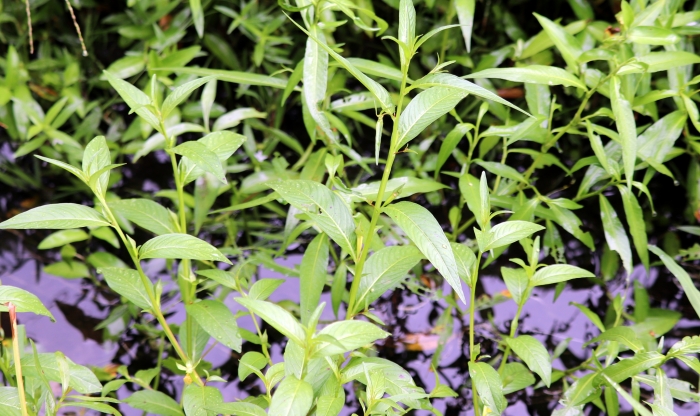Willow Primrose
(Ludwigia decurrens)
Willow Primrose (Ludwigia decurrens)
/
/

Lauren McLaurin
CC BY 4.0
Image By:
Lauren McLaurin
Recorded By:
Copyright:
CC BY 4.0
Copyright Notice:
Photo by: Lauren McLaurin | License Type: CC BY 4.0 | License URL: http://creativecommons.org/licenses/by/4.0/ | Rights Holder: Lauren McLaurin | Publisher: iNaturalist | Date Created: 2018-09-02T17:43:49-07:00 |



















Estimated Native Range
Summary
Ludwigia decurrens, commonly known as willow primrose or wingleaf primrose-willow, is an annual herb native to floodplains, ditches, and wetlands in the central and eastern United States. It can reach up to 6 feet in height, with an erect form and distinctive winged stems. The leaves are linear to lanceolate, and the plant produces bright yellow, four-petaled flowers in the summer months. The flowers are not particularly showy but are followed by seed capsules that can contain a prolific number of seeds, sometimes up to 1000 per capsule.
Willow primrose is valued for its ability to thrive in wet conditions, making it suitable for rain gardens and areas with poor drainage. It is also used for erosion control due to its fast growth rate and extensive root system. In cultivation, it prefers full sun to part shade and consistently moist to wet soil conditions. While it can be a beneficial plant in its native range, Ludwigia decurrens has become invasive in other parts of the world, such as Africa and Southeast Asia, where it can aggressively colonize rice paddies and wetlands, outcompeting native species and disrupting local ecosystems. Gardeners should be cautious about planting it in areas where it is not native to prevent potential invasiveness.CC BY-SA 4.0
Willow primrose is valued for its ability to thrive in wet conditions, making it suitable for rain gardens and areas with poor drainage. It is also used for erosion control due to its fast growth rate and extensive root system. In cultivation, it prefers full sun to part shade and consistently moist to wet soil conditions. While it can be a beneficial plant in its native range, Ludwigia decurrens has become invasive in other parts of the world, such as Africa and Southeast Asia, where it can aggressively colonize rice paddies and wetlands, outcompeting native species and disrupting local ecosystems. Gardeners should be cautious about planting it in areas where it is not native to prevent potential invasiveness.CC BY-SA 4.0
Plant Description
- Plant Type: Herb
- Height: 1.5-3 feet
- Width: 1.5-3 feet
- Growth Rate: Rapid
- Flower Color: White, Yellow
- Flowering Season: Summer, Fall
- Leaf Retention: Deciduous, Semi-deciduous
Growth Requirements
- Sun: Full Sun
- Water: High
- Drainage: Medium, Slow
Common Uses
Bird Garden, Low Maintenance, Water Garden
Natural Habitat
Floodplains, ditches, and wetlands in the central and eastern United States
Other Names
Common Names: Willow Primrose, Decurrent False Loosestrife, Winged Water-Primrose, Wingleaf Waterprimrose
Scientific Names: , Ludwigia decurrens, Diplandra compressa, Diplandra decurrens, Diplandra heterophyla, Diplandra montana, Diplandra pumila, Jussiaea alata, Jussiaea alata, Jussiaea bertonii
GBIF Accepted Name: